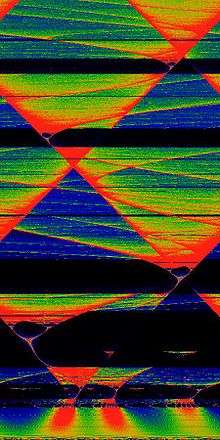Mary Tsingou
Mary Tsingou (married name: Mary Tsingou-Menzel; born October 14, 1928)[1] is an American physicist and mathematician of Greek ancestry. She is known for being one of the first programmers on the MANIAC computer at Los Alamos National Laboratory and for work in conjunction with Enrico Fermi, John Pasta, and Stanislaw Ulam which became the inspiration for the fields of chaos theory and scientific computing.
Mary Tsingou | |
|---|---|
| Born | Mary Tsingou 14 October 1928 Milwaukee, Wisconsin |
| Citizenship | United States |
| Alma mater | University of Wisconsin University of Michigan |
| Known for | Fermi–Pasta–Ulam–Tsingou problem |
| Scientific career | |
| Fields | Physics Scientific computing |
| Institutions | Los Alamos National Laboratory |
Life
Mary Tsingou was born in Milwaukee, Wisconsin, her Greek parents having moved to the US from Bulgaria. In the aftermath of the Great Depression, the family left the US to spend several years in Bulgaria. In 1940, they returned to the US, where Tsingou attended high school and college. She graduated in mathematics and education in 1951 from the University of Wisconsin. She then studied at the University of Michigan, receiving a master's degree in mathematics in 1955. In 1958, she married Joseph Menzel.[2]
Career
Tsingou joined the T1 division of the Los Alamos National Laboratory, then transferred to the T7, where she became one of the first programmers on the MANIAC. Besides working on weapons, the group also studied fundamental physics. Following Fermi's suggestion to analyze numerically the predictions of a statistical model of solids, Tsingou came up with an algorithm to simulate the relaxation of energy in a model crystal, which she implemented on the MANIAC.[2] The analysis became known in the computational physics community as the Fermi–Pasta–Ulam–Tsingou problem (FPUT), and Tsingou's contributions have since been recognised.[3][4] The result was an important stepping stone for chaos theory.
After Fermi's death, James L. Tuck and Tsingou-Menzel repeated the original FPU results and provided strong indication that the nonlinear FPU problem might be integrable.[5]
Tsingou-Menzel continued her computational career at Los Alamos. She was an early expert on Fortran. In the 1980s, she worked on calculations in the Star Wars program. She retired in 1991.[2]
Recognition
In 2008, an article published in Physics Today called to rename the FPU problem to the FPUT problem to give her proper credit for her contribution. Subsequent publications referencing the FPUT problem reflect this change.[6][2]
Publications
- J. L. Tuck; M. T. Menzel (1972). "The superperiod of the nonlinear weighted string (FPU) problem". Advances in Mathematics. 9 (3): 399–407. doi:10.1016/0001-8708(72)90024-2.
- Joseph J. Devaney, Albert G. Petschek, Mary Tsingou Menzel. On the Production of Heavy Uranium Isotopes in a Very High Density Fast Neutron Flux (accessed Dec. 2012). Los Alamos Scientific Laboratory of the University of California, 1958; 17 pages.
See also
References
- Mary Tsingou Menzel. IEEE Global History Network: Oral Histories. Accessed Nov 2012.
- Dauxois, T. (January 2008). "Fermi, Pasta, Ulam, and a mysterious lady" (PDF). Physics Today. 61 (1): 55. arXiv:0801.1590. Bibcode:2008PhT....61a..55D. doi:10.1063/1.2835154.
- Fermi, E.; Pasta, J.; Ulam, S. (1955). "Studies of Nonlinear Problems" (PDF). (Accessed Nov 2012) Document LA-1940. Cite journal requires
|journal=(help) Also appeared in Collected Works of Enrico Fermi, University of Chicago Press, Vol. II, 978–988 (1965). Note: In Fermi's case, this work is postmortem, published after his death in 1954. - Fermi, E. et. al (1955). _______ . Front page: "Work done by: E. Fermi J. Pasta S. Ulam M. Tsingou"; and footnote: "We wish to thank Miss Mary Tsingou ... for running the computations on the Los Alamos MANIAC machine, ..."
- Tuck, J. L.; Menzel, M. T. (1972). "The Superperiod of the Nonlinear Weighted String (FPU) Problem". Advances in Mathematics. 9 (3): 399–407. doi:10.1016/0001-8708(72)90024-2.
- Dauxois, T.; Ruffo, S. (2008). "Fermi-Pasta-Ulam nonlinear lattice oscillations". Scholarpedia. 3 (8): 5538. Bibcode:2008SchpJ...3.5538D. doi:10.4249/scholarpedia.5538.
External links
- Pioneer Women in Chaos Theory. Frank Y. Wang.
- The Fermi–Pasta–Ulam “numerical experiment”: history and pedagogical perspectives. Dauxois, Peyrard and Ruffo.
- A not-so-mysterious woman, Los Alamos Monitor online.
- A wrong righted, Philosophy of Science Portal, A Venue for Discussions of Science, Philosophy and the Arts
- Mary Tsingou-Menzel Oral History

